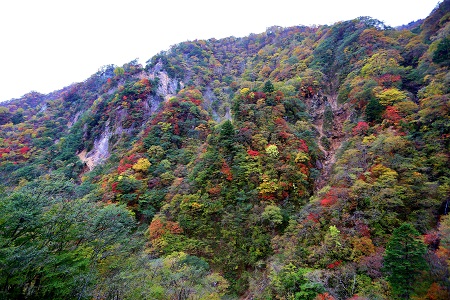I visited Toshogu Shrine to see biological impacts of Fukushima No.1 nuclear power plant accident. Though I have visited various places in Japan to see the health consequences of the accident, I have never found any effect against creatures in Japan.
Toshogu Shrine is located in Nikko city, Tochigi prefecture. It was built in 1617 as the mausoleum of the Tokugawa Ieyasu. The main shrine buildings were built by the third shogun, Tokugawa Iemitsu in 1636. Building of the Toshogu represented the climax of the Gongen-zukuri style which characterizes Japanese shrine architecture. Skills of the highest level available at the time were applied to the architectural decoration such as carvings and coloring. Eight buildings such as the honden (main hall), the Ishi-no-ma (stone hall), the haiden (worship hall), and the Yomei-mon (tower gateway) have been designated as National Treasures, whereas further thirty-four buildings as Important Cultural Properties.
Nikko and the Okunikko area around Lake Chuzenji, in particular, are well known for their beautiful autumn colors (koyo). Thanks to the 2,000-meter difference between its highest and lowest elevations, Nikko's autumn color season lasts nearly two months. The earliest colors usually debut in the highest mountain peaks in Okunikko in early October and slowly roll down the slopes, reaching the lower areas around Toshogu Shrine by mid November.
Generally speaking, plant's growth is so fast than human beings that they are more sensitive to radioactive materials of the environment than us. So I visited Nikko city to see effects of the accident against creatures which are grown up in Japan.
Fortunately, I could see them grown up safely and I couldn't find any impact of the accident. It seems that there is no problem for childbirth and child-rearing in Tochigi prefecture, Japan.
Posted by Yoshitaka Kiriake from Japan on (November 18, 2014)
日光東照宮で有名な栃木県の日光は標高がありスロープ状の地形のため紅葉が美しく鑑賞期間も長いことで有名です。紅葉は高所から麓へ徐々に広がり、10月から11月までが見頃です。2014年10月撮影。
Guardian deity statues of Omotemon (Front Gate) at Toshogu Shrine
Koyo ; Nikko area is well known for their beautiful autumn colors.
It takes about 2 hours from Tokyo to Nikko.
Access
Shinkansen
Shinkyou (Sacred Bridge)
神橋
Google map
Shinkyo, or the sacred bridge, is known to have existed already on the present site spanning the Daiya River in the Muromachi Period (according to remaining archival records) though the exact date of its construction is not clear. It was in 1636 that this bridge took on its present style as a vermilion-lacquered wooden bridge on massive stone piers piled down close to the riverbanks. Though demolished in a flash flood in 1902, it was reconstructed and restored to its 17th -century condition in 1904.
THE WORLD HERITAGE SHRINES AND TEMPLES OF NIKKO
Nikko Perfect Guide
About Nikko Toshogu Shrine
Google map
日光東照宮
The shrine complex was registered as a World Heritage site in December 1999.
Ishidorii (Stone Torii Gate)
石鳥居
Omotemon (Front Gate)
表門
Omotemon (Front Gate) is also called Nio Gate because of the two guardian deity statues positioned on the left and right.
仁王像
Gojunoto (Five-Story Pagoda)
五重塔
Shinkyusha (Sacred Stable) and Sanzaru (Three Wise Monkeys)
神厩舎・三猿
The “See No Evil, Speak No Evil, Hear No Evil” carving of three monkeys is particularly famous.
Sanjinko (Three Sacred Storehouses)
三神庫
Yomeimon Gate
陽明門
The shrine buildings are in constant need of maintenance.
Kairo (Corridor)Designated a National Treasure The exterior wall of the building extending to the left and right of Yomeimon Gate is decorated with flower and bird carvings that are considered among the best in Japan. All the carvings are single-panel openwork painted in vivid colors.
廻廊
Karamon Gate
唐門
Korou (Drum Tower)
鼓楼
Shinyosha (Portable Shrine House)
神輿舎

Nemurineko (Sleeping Cat)
眠り猫
Lake Chuzenji
Google map
中禅寺湖
Koyo ; autumn foliage, Japanese Maple leaves turn red from green
華厳の滝
Kegon Falls
Google map
There are 48 waterfalls in Nikko, but Kegon waterfall is the most famous among these. The water falls from 97 meters high and you will enjoy natural beauty around the fall.
Koyo : Red or yellow leaves in autumn.
Japanese foods are good and safe.
Because of stricter food safety law by Japanese government, we have no worry about foods.
Ekiben ; box lunch sold on a train or at a station
Dango : skewered rice dumplings with a sweet soy glaze
Yuba ; tofu skin, dried beancurd, delicacy made from the skin of gently boiled soybean milk
Ayu Shioyaki ; Grilled sweetfish with salt
Suiton ; flour dumplings boiled in soup
Fortunately I have never found any impacts by the accident among Japanese creatures. As far as I know, nobody has health problem which is caused by the accident in Japan.
Our Prime Minister Abe assures that "The situation is under control. The influence of the contaminated water is completely blocked within Fukushima. There are no health-related problems until now and there will never be health problems." He also said that "Tokyo is 250 kilometers away from Fukushima, and the kind of danger that you imagine does not exist in Tokyo. Tokyo is a very safe city."
As PM Abe said, Tochigi prefecture is very far away from Fukushima, people in Tochigi have no concern about the nuclear power plant accident. People in Tochigi have already forgotten the accident, because they think radioactive materials cannot reach there.
We know there is no problem for child birth and child rearing in Tochigi prefecture. So people in Tochigi are living without any concern about the accident.
I continue to visit various places in Japan to see the effects of the accident, because I can meet various creatures which are more sensitive to radioactive materials from the environment. It is important to see their health for our safety.
公衆衛生ネットワーク
Public Health Network in Japan





































0 件のコメント:
コメントを投稿